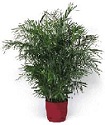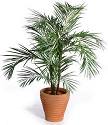We’ve all felt it; our sense of smell getting assaulted by various odours and chemicals in the air. Although the smells may not be unpleasant or even noticeable, some can affect our overall health, so I wanted to talk about some natural ways to counteract this in your home.
An air purifier is a recommended idea by most people, but they can run anywhere from $100-$1200 depending on the make and model you choose. I’m trying to be frugal (to the letter) and I unfortunately don’t have that kind of money just floating around. So I set off on a search for an inexpensive alternative that would satisfy my need for cleaner air, but wouldn’t break the bank at the same time. The results of what I found were as surprising as they were interesting.
There’s no doubt that you were taught as a child about how trees produce oxygen, but were you aware that your common houseplant does the same? They are often over-looked and tend to be considered more of an accent piece, but they are good helpers in counteracting outgassing, ridding the air of toxins and pollutants as well as contributing to an internal balanced humidity. They also help you breath better and even sleep better. And on top of it all, they are cheaper and more attractive than their machine counterparts. What more could you possibly ask for? Here are the top 6 household plants that I have researched to help purify the air, with some interesting tidbits too, as each has their own super powers.
Bamboo Palm

Bamboo Palms are easy to care for plants, and thrive in well-lit locations. It helps remove formaldehyde which is found in things like automobile exhaust and tobacco smoke. It also acts as a natural humidifier for your home, consequently helping to improve sinus problems and to prevent dry skin in the winter.
Average price: About $20 per plant.
Snake Plant

Besides helping purify the air, the Snake Plant is also the easiest plant to take care of and will even grow nicely with those who lack green thumbs. It doesn’t need much watering and it doesn’t require constant bright light. It helps remove formaldehyde and nitrogen oxides; a by-product of gas stoves, internal combustion and many other things.
Take note that this plant is toxic to humans and animals when eaten.
Average price for a Snake Plant:About $10
Areca Palm

The Areca Palm is the top rated plant by NASA (I didn’t know this organization kept such lists, did you? I wonder what item tops the utensils list? I bet it’s the spoon.) and is said to be the most efficient air humidifier. It constantly rids the air of chemical toxins and keeps the space moist during dry times. It can virtually replace electric humidifiers if you were to have enough of these in one area! The only downside is that this plant needs more care and watering than most.
Average price for a Areca Palm: About $90
Spider Plant

The Spider Plant also helps remove formaldehyde from the air as well as allergens, mold, bacteria and carbon monoxide; a deadly, odourless toxin that is a product from stoves and most sorts of combustion. Besides requiring little watering, this plant is an amazing buy because, with some help, it can reproduce quite easily (it’s asexual) and you can re-pot its shoots to grow other spider plants.
Average Price of a Spider Plant: Between $10-$15
Peace Lily

The Peace Lily has been dubbed the “Clean-All” Plant. Not only is it a beautiful plant to look at, it also helps clean the air of Benzene, Trichloroethylene, Formaldehyde, mold spores and other airborne chemicals. It does require a lot of light and watering, but it is still worth it for all the benefits it gives back.
Be warned that this plant is mildly toxic to humans and animals, so don’t ingest it.
Average Price of a Peace Lily: Between $20-$50
Gerbera Daisy

The Gerbera Daisy is the fifth most popular flower in the world, and it’s easy to see why. It comes in a variety of colours and sizes and is beautiful to look at. It is also said to help improve sleep at night. It absorbs carbon dioxide and releases more oxygen at night, which is proven to help you get a better rest at night. It also removes Benzene from the air.
Average Price of a Gerbera Daisy: Anywhere from $20-$90, depending on if you buy from a florist or a nursery.
With a little TLC, plants and flowers can bloom and thrive just about anywhere. It’s not necessary to have a green thumb either for most plants; you just need to not forget about them — and talk to them once in a while. Besides being pretty to look at, plants also improve your quality of life for a fraction of the price of electric air purifiers. What do you have in your home, plant-wise?

I had no idea the Spider Plant was toxic. I only have one at the office, but my parents’ cottage is full of them and they often catsit for me…
My personal trick for keeping the cats away from just about anything is to occasionally spray a little bit of lemongrass. They hate the smell so much, it even works for keeping them out of the Christmas Tree!
Thanks for the info!
Haha, that’s what I use to do as well, with the lemongrass :) We had one too many adventures with my cat climbing the tree when I was younger!
I’m glad you like it!
Very interesting! Do you happen to know if these plants are all non-toxic? Greenifying my condo is tempting, but I’d want to make sure I don’t put my little furry friends in any sort of danger.
Hey Ariane :) The only ones that are toxic are the Snake Plant, the Spider Plant and the Peace Lily. I have a furry friend myself at home so I made sure to double check this for you ;)